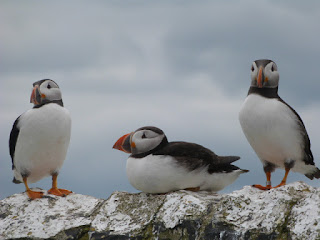It has been far too long since I have written my blog. So to get going again here are some photos from a fantastic day trip I had out to the Farne Islands earlier this summer to see two of my favourites, puffins and seals...along with a whole lot of other bird species. The Farne Islands boast a large seabird colony with 23 different species to be seen along with an abundance of grey seals. The Farnes are a cluster of Islands off the Northumberland coast and easily accessed by boat from Seahouses. Below are just some of the highlights of a great way to spend a day surrounded by wildlife!
 |
| Grey Seals |
 |
| Young Seal basking in the sun |
As we approached the Farnes we cruised around the cliffs geting a closer look at all the bird life. The most dominant species being the Guillemot, Uria aalge. The guillemots nest in huge colonies all around the Islands.
 |
| Guillemot, Uria aalge |
 |
| Guillemot, Uria aalge |
 |
| Bird watcher's Paradise |
 |
| Arctic tern chick |
 |
| Arctic Tern with Sand Eel |
I felt a bit of an intruder and did ask the rangers if they thought we have an effect on the terns as they were wasting all this energy on warning the humans away. The rangers thought that the terns would behave in this way anyway as they spend all day protecting their young against other birds.
I moved on up the boardwalk to enjoy what I had really come to see, the Puffins, Fratercula arctica and I was not disappointed. I have always wanted to get one of those classic photos of a puffin with sand eels in its beak. Now I'm not a great photographer and I have a pretty basic camera but I just wanted to photograph these adorable looking birds.
 |
| Puffin showing off his catch of sand eels |
 | |
| Puffin proudly showing off his catch |
 |
| Kittiwake with chick |
 |
| Guillemot, chick and Razorbill |
 | |
| Razorbill - showing off his bill! |
We also saw a number of shags, Phalacrocorax aristoelis, often confused with the Cormorant, Phalacrocorax carbo. The shag has a green sheen to its feathers and the cormorant is more blue and black. The shag's beak is also quite a vibrant orange and if you still can't tell them apart you are safe to say you saw a shag on Inner Farne as the cormorant does not nest there!
 |
| Shag and fluffy chick |
 |
| Shag |
 | ||
So I will leave you with another seal photo and I hope this has given you a taste of what there is to see out on the Farnes. My little trip to the Farnes took me right back to when I visited the Galapagos Islands in 2009. It truly is a remarkable experience to see wildlife so close up and in its natural environment. Even if you are not an avid bird watcher you will enjoy a trip out to the Farnes. The other good time to visit is in October when the seal pups start to arrive and with it now being September I feel another visit coming on!!






No comments:
Post a Comment